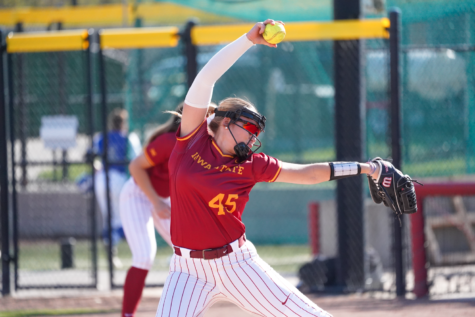Football coaches use comprehensive concussion tests
October 8, 2002
After Joe Woodley suffered a concussion in Iowa State’s game against Kansas, he wasn’t sure what was going on.
“I guess I got up and I started walking up towards our locker room,” Woodley said. “That’s how bad it was — I didn’t know where I was at.”
He said he had to rely on videotape to find out what happened in the moments following the injury.
Woodley, a fullback and reserve linebacker for the Cyclones, sustained the injury after he made a tackle with his head down on Iowa State’s second kickoff. He said his teammates told him he made a great hit, but he really doesn’t remember it.
Woodley said a bad headache, ringing in his head and dizziness set in shortly after he made the play. He said one of the student assistant athletic trainers noticed his blank stares towards the ground and asked him if he was all right.
“I obviously must have told them ‘yeah’ because I went back out on offense,” Woodley said. “After I came back out on offense, I think I do remember saying ‘hey, I don’t know where the hell I’m at and I don’t know what’s going on.'”
The junior was held out for the rest of the game against the Jayhawks. Woodley’s case is not uncommon in collegiate athletics. Just last month, Colorado’s former starting quarterback, Craig Ochs, suffered his third concussion in a year and will miss the rest of the season.
At Iowa State, head athletic trainer Mark Coberley and his staff are in charge of preventing, diagnosing and treating injuries, including concussions. While new technology helps athletic trainers diagnose concussions, there are still some gray areas about the exact physiology behind the injury.
“That’s why it’s difficult to determine when it’s fine to put someone back in,” Coberley said.
Iowa State gives every football player two sets of tests in the summer to determine an athlete’s base rates from a neurological standpoint.
The Standardized Assessment of Concussion (SAC) test measures all the areas of cerebral function and can be carried out on the sidelines during a game. Coberley and his staff then compare these scores to a player’s base rates and determine when it is safe for an athlete to play again.
When a player has sustained a first-degree concussion, scores will usually normalize around the base rate within 20 minutes, Coberley said.
If scores have not returned to normal, Coberley said they can use another testing procedure called Immediate Post-concussion Assessment and Cognitive Testing (IMPACT) — a computer-driven, neuropsychological exam developed by concussion experts. The IMPACT test, which is also used by some NFL teams, measures all the things having to do with an athlete’s mental function. With that data, Coberley said he can determine where a player is in the healing process.
“Our concussion program that we have in place here is about as comprehensive as you can have at any level,” Coberley said.
Even with all the technology put into use, some players, like Woodley, will undoubtedly go undiagnosed and return to action, but Coberley said his staff and other players keep an eye out for athletes who might have a concussion. The athletes are informed about the symptoms and risks involved with concussions, Coberley said.
“The brain is an area that you really don’t want to mess around with too much, so our guys are pretty straightforward and honest,” Coberley said.
















